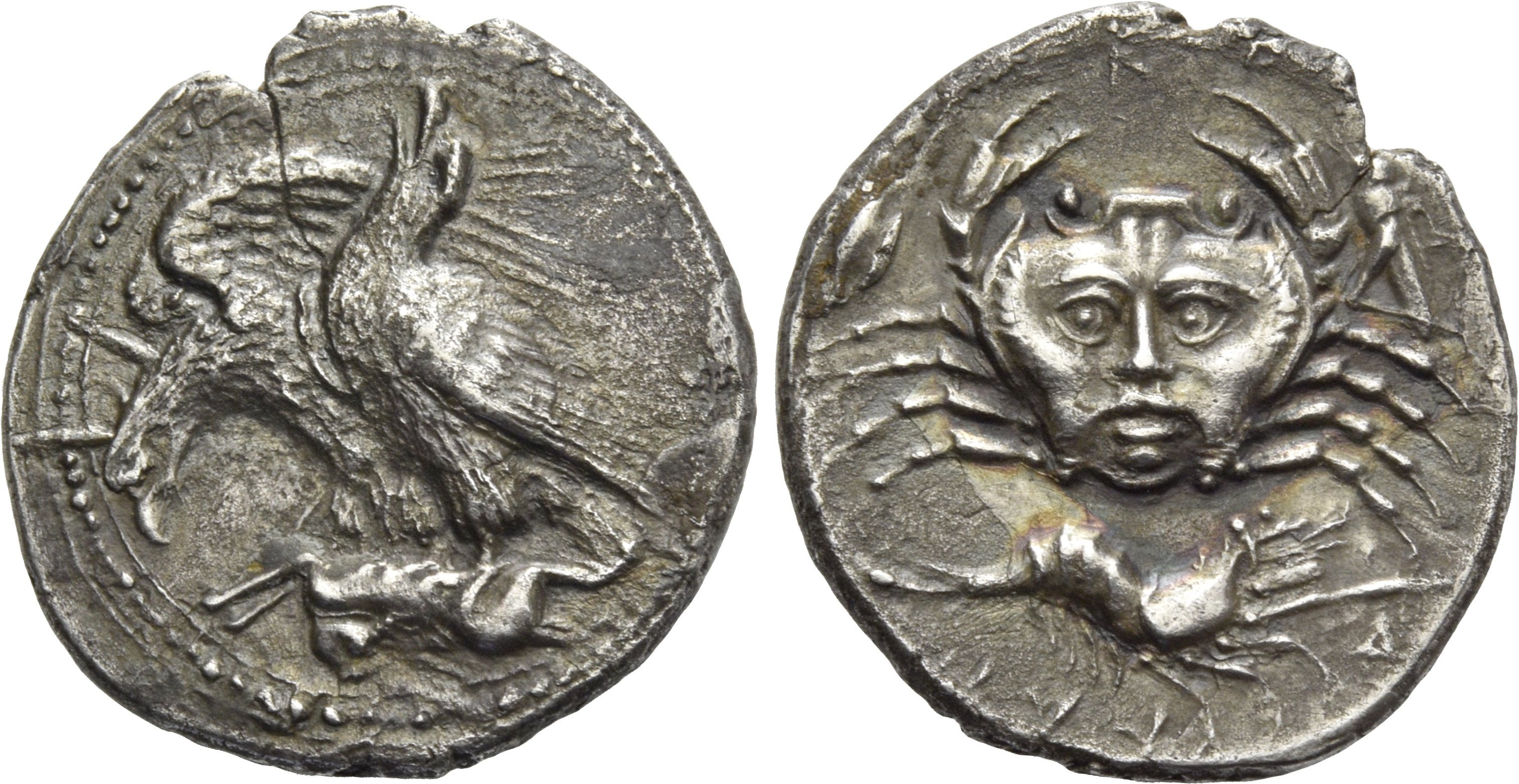Agrigentum, silver, drachms (eagles on hare/crab & crayfish) (410-406 BCE)
From SILVER
410 BCE - 406 BCE Silver 82 kg
Description
| ObverseInscription or printing placed on the obverse.: | Two eagles perched l. on carcass of hare, further eagle, wings half open, leaning forward to peck, the nearer, with closed wings, throwing back head to screech |
| ReverseInscription or printing placed on the reverse.: | AKP – AΓAN (Greek).Crab seen from above, the carapace turned into human face, beneath, crayfish. On l. and r., barley grain and locust |
Mint and issuing power
| MintIdentifies the place of manufacture or issue of a numismatic object.: | Agrigentum | Ancient regionAncient region.: | Sicily | Modern countryModern country: Italy | AuthorityIdentifies the issuing power. The authority can be "pretended" when the name or the portrait of X is on the coin but he/she was not the issuing power. It can also be "uncertain" when there is no mention of X on the coin but he/she was the issuing power according to the historical sources: |
Chronology
| FromIdentifies the initial date in a range assigned in a numismatic context. | 410 BCE | toIdentifies the final date in a range assigned in a numismatic context.. | 406 BCE | PeriodTime period of the numismatic object.: Classical 480-323 BC |
Physical description
| MetalThe physical material (usually metal) from which an object is made.: | Silver |
Median weightMedian of the weights of numismatic objects (in grams). in grams | 4.10 | DenominationTerm indicating the value of a numismatic object. Examples: tetradrachm, chalkous, denarius.: | drachma |
StandardStandard.: | Attic |
Image

S 1504 - Agrigentum, silver, drachms (410-406 BCE).jpg [1]
References
| Die study referencePublication of the study: | Westermark 20181Westermark 2018, p. 202, n° 604 | ||
| Coin series referenceReference to coin series study: | |||
| Coin series web referenceCoin series web references: | |||
Obverse dies distribution
| FrequencyFrequency of specimen in distribution. ᵖ | Number of obversesNumber of obverse dies. ᵖ (o) | % (o) | Number of coinsNumber of coins. (n) | % (n) | Die nameName(s) of the die(s). |
| 13 | 1 | 100 | 13 | 100 | 1 |
| Total | 1 of 1 | 100 | 13 of 13 | 100 |
Reverse dies distribution
no distribution is available
Quantification
| Number of obversesNumber of obverse dies. ᵖ (o) | 1 | Number of singletons (o1)The number of singleton coins. ᵖ | |
| Number of reverse diesNumber of reverse dies. (r) | 1 | Number of coinsNumber of coins. (n) | 13 |
| Coins per obverse dieNumber of coins per obverse die. (n/o) | 13 | Coins per reverse dieNumber of coins per reverse die. (n/r) | 13 |
| Reverse per obverse ratioRatio of obverse dies divided by reverse dies. (r/o) | 1 | Percentage of singletons (o1)number of coins (n) divided by the number of singletons (o1) ᵖ | % |
| Original number of dies (O) (Carter 1983 formula)The estimation of the number of coins according to Carter 1983 ᵖ | 1 | Coins struck if 20,000 as average productivity per dieCoins made if the average productivity for obverses (according to Carter) is 20,000. ᵖ | 20,000 |
| Original number of dies (O) (Esty 2011 formula)The estimation of the number of coins according to the singleton formula in Esty 2011 ᵖ (O) | 1.08 | Survival rate if 20,000 as average productivity per dieSurvival rate if average productivity is 20,000. ᵖ | 0.00065 |
| Coverage (o = % of O) (Esty 1984 formula)Esty 1984 - coverage (% of O) ᵖ (o = % of O) | % | Die productivity if survival rate 1/2,000Average productivity if survival rate is 1/2,000. ᵖ | 26,000 |
| Weight of silver (in kg) if 20,000 coins per die (O = Carter formula)Carter 1983 * Median weight * 20000 (*10 if gold or electrum) ᵖ | 82 kg <br /> 82 kg | Die productivity if survival rate 1/5,000Average productivity if survival rate is 1/5,000. ᵖ | 65,000 |
Remarks
References
- ^ Westermark, Ulla (2018), The coinage of Akragas c. 510-406 BC, 2 vol., Uppsala.